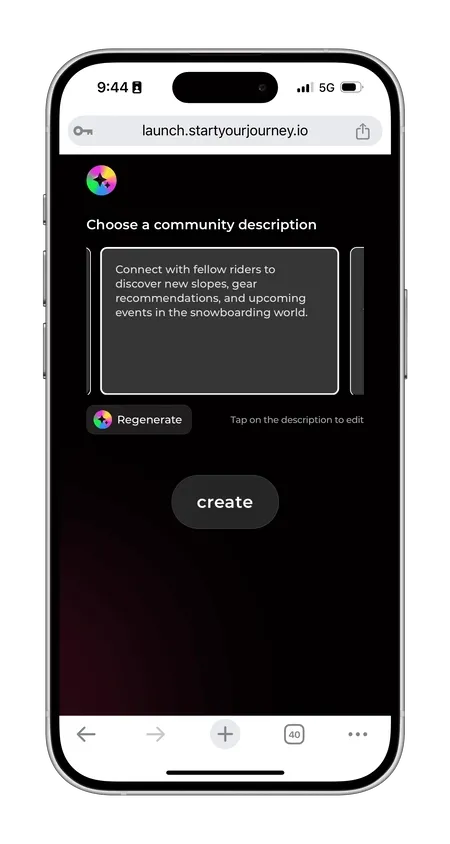Community building is more than just a buzzword; it's a powerful process that shapes how individuals connect, interact, and form supportive networks. At its core, community building involves creating and sustaining environments where shared interests, values, or goals thrive.
This process is crucial in fostering relationships that provide social support and enhance personal and collective well-being. By delving into the definitions and insights of community building, individuals can better understand how to forge genuine connections in today’s complex social landscape. Through intentional strategies and platforms like the Journey app, users can cultivate communities that offer real substance and meaningful engagement. Embrace these insights to master the art of community building and unlock the potential of thriving, connected networks.

Community building is the purposeful endeavor of forming, nurturing, and sustaining meaningful relationships among individuals who share common interests, values, or goals. At its core, it fosters a sense of belonging and social support by connecting like-minded individuals in an environment that encourages mutual growth and collaboration.
Central to effective community building are active engagement, trust creation, and consistent communication. These elements form the backbone of vibrant communities where members feel safe and motivated to participate. Platforms like Journey enable users to create and maintain genuine connections through focused tools that support authentic interactions, customizable member roles, and seamless communication channels. Journey’s approach emphasizes substance over superficiality, helping communities grow organically while providing a rich hub for shared experiences and ideas.
Understanding community building involves both academic insights from sociology and practical strategies that guide real-world applications. This dual perspective highlights why establishing clear goals, fostering trust, and leveraging technology are crucial in building communities that endure and thrive.

Community building traditionally thrived on face-to-face interactions within local neighborhoods, workplaces, and social groups. These in-person connections fostered a shared sense of belonging and mutual support grounded in physical proximity. However, technological advancements have dramatically shifted this landscape. The rise of the internet and social media platforms expanded community building beyond geographic boundaries, enabling people to connect globally in real time. This expansion facilitated diverse, vibrant communities with shared interests regardless of physical location, transforming how individuals discover, engage, and sustain relationships.
Digital solutions like Journey have revolutionized this evolution by offering tailored tools that foster genuine interpersonal connections. Journey’s platform caters to those seeking authentic engagement through customizable community creation, seamless communication channels, and AI-powered support. Its features—including group chats, event organization, and member directories—enable users to participate in focused discussions and collaborative projects that align with their passions. By emphasizing substance over superficiality, Journey nurtures a trustworthy environment where communities can grow organically and members feel valued and connected.

Successful community building hinges on several core elements that serve as the foundation for meaningful and lasting connections. Setting clear objectives is critical, as it establishes a shared mission that aligns members’ expectations and directs collective efforts. Fostering trust within the community creates a safe and trustworthy environment where individuals feel valued and encouraged to contribute. Open communication further supports this by enabling transparent dialogue and continuous interaction, which strengthens relationships and nurtures a sense of belonging.
Engagement strategies play a crucial role in maintaining vibrant communities. Consistent interaction among members keeps the community dynamic and relevant. Tools that facilitate structured conversations and group activities help sustain this momentum by providing focused spaces for members to participate actively. Journey exemplifies this approach by offering features like group chats, community feeds, and customizable member roles that encourage ongoing, meaningful engagement. These tools empower community owners and members to cultivate rich discussions and collaborative experiences that enhance overall interaction.
Leadership and a shared vision are essential for guiding communities toward long-term growth. Effective leadership supports community members by providing direction, resolving conflicts, and inspiring participation. A well-led community with a clear vision encourages members to invest their time and energy, resulting in a robust and fulfilling network. This synergy between leadership and collective purpose ensures that communities evolve organically while maintaining focus on their core goals.

Community building is best understood through various frameworks that reveal the underlying processes shaping connection and engagement. These frameworks, grounded in sociology, psychology, and participatory models, provide a structured lens to examine how communities form, sustain themselves, and evolve over time. They emphasize the importance of shared values, trust, and continuous interaction as the essence of community building.
Sociological approaches analyze community building by focusing on social structures, roles, and norms that influence group dynamics. For instance, symbolic interactionism highlights how shared meanings and communication create bonds between members. Participatory models stress active involvement and empowerment, encouraging members to contribute meaningfully and collaboratively. These frameworks together offer a rich understanding of the mechanisms that sustain robust community ecosystems.
In practical settings, these theoretical perspectives guide the design and management of communities to foster long-term engagement and growth. Platforms like Journey integrate these insights by providing tools that support customizable member roles, seamless communication, and AI-assisted moderation. This blend of theory and technology creates safe, vibrant environments where individuals can discover, participate, and contribute authentically, enriching the community experience.

Community building is crucial for society as it creates a fulfilling environment where individuals find emotional support and practical assistance. By fostering collaboration among like-minded members, communities become hubs for sharing ideas, resources, and experiences. This spirit of mutual support strengthens social bonds and encourages continuous participation. Platforms like Journey enhance this process by providing tools that nurture authentic social interactions, enabling members to engage deeply and meaningfully within safe and trustworthy spaces.
From a business perspective, community building drives long-term customer retention and loyalty. Engaged communities act as advocates, promoting brands organically and reducing marketing costs. Research shows that businesses integrating community marketing tactics see improved communication skills among members, greater collaboration, and stronger peer relationships. Journey supports these outcomes by offering seamless engagement features, customizable member roles, and insightful analytics that guide community owners in expanding and enriching their networks.

Building a vibrant community starts with strategic actions that give it purpose and structure. Defining a clear mission aligns members around shared goals and fosters a sense of belonging. Organizing regular interactive events keeps the community dynamic and encourages ongoing participation. Journey supports these efforts by offering seamless event planning tools, customizable member roles, and AI-powered assistance to ensure every event resonates with the group’s interests and needs. This blend of strategy and technology creates a safe, trustworthy environment where genuine connections flourish.
Effective community activities range from indoor team-building exercises to casual meet-ups that promote collaboration and trust. Virtual meet-ups and chats offer flexible, accessible ways for members to engage regardless of location, while collaborative projects deepen relationships through shared contributions. Discussion forums provide a structured space for meaningful conversations, and regular newsletters keep members informed and connected. Local community events help ground online relationships with in-person interaction, enriching the overall experience. Journey’s platform integrates these activities, enabling groups to organize, promote, and manage events effortlessly while supporting diverse engagement styles.
Consistency is critical for sustaining community energy and long-term growth. Follow-up after events, ongoing communication, and continuous opportunities for members to participate help maintain momentum. Journey’s AI Sidekick plays a vital role in this process by sending personalized reminders, curating relevant content, and facilitating accountability groups that encourage mutual support. This continuous cycle of engagement strengthens bonds and transforms communities into thriving hubs of shared learning and growth.
.png)
Community building encounters several critical challenges that can undermine its long-term success. Engagement drop-offs often occur when members lose interest or feel disconnected, weakening the community’s core. Conflict resolution is another significant hurdle; unresolved disputes can erode trust and fracture the social fabric of a group. Communication barriers—whether due to unclear expectations or lack of transparency—also hinder the continuous interaction essential for vibrant communities.
Overcoming these barriers requires a blend of clear guidelines, proactive moderation, and open dialogue. Establishing well-defined rules sets expectations that safeguard trust and credibility. Implementing mediation strategies helps manage conflicts before they escalate, ensuring a safe and trustworthy environment. Encouraging regular interaction, through scheduled events or discussion prompts, sustains momentum and fosters mutual participation. Journey supports community owners by providing AI-powered moderation tools, customizable member roles, and seamless communication channels that enable effective oversight and engagement. Its AI Sidekick assists in detecting issues early and facilitates conflict resolution, creating a robust framework for communities to thrive.

Technological advancements have become the backbone of modern community building, enabling diverse individuals to connect across the globe in real time. Innovations such as mobile applications, AI-powered management, and seamless communication tools have transformed how communities form, grow, and thrive. Platforms like Journey exemplify this evolution by offering a robust, well-maintained environment that supports genuine interactions and meaningful engagement. Journey’s AI Sidekick enhances community management by automating moderation, personalizing onboarding, and curating relevant content, ensuring communities remain vibrant and trustworthy hubs for sharing ideas, resources, and experiences.
Looking ahead, the future of community building will be shaped by continued digital innovation, enabling even richer, more interactive experiences. Emerging technologies promise enhanced virtual events, granular data insights, and deeper integration with social media platforms to expand discoverability and participation. These trends will empower community owners and members alike to foster continuous growth, collaboration, and personal development within safe and supportive environments.
"Understanding the community building definition is vital in today's interconnected world. Community building is about forming and sustaining relationships among individuals with shared goals, fostering environments for collaboration and engagement. This holistic approach requires intentional strategies that nurture trust and consistent interaction.
As digital tools continue to evolve, they enhance how communities connect and engage, making the future of community building exciting. Platforms like the Journey app exemplify this evolution, offering ways to maintain structured, authentic interactions. By embracing both traditional and digital methods, individuals and organizations can create vibrant communities that thrive on support, motivation, and shared purpose.
These insights empower users to enhance their community efforts, ensuring that community building remains a cornerstone for societal and personal growth.
Community building in psychology and sociology involves creating, nurturing, and sustaining relationships among individuals with shared interests or goals, emphasizing active engagement, trust, and collaboration in social networks.
Examples of community building include organizing local meet-ups, virtual gatherings, collaborative projects, discussion forums, and community service events that foster genuine connections and cooperative spirit.
Community building is essential as it enhances support networks, fosters collaboration, strengthens social bonds, and promotes individual and group growth, critical for personal development and societal progress.
The four stages of community building typically include forming, storming, norming, and performing, where groups evolve from initial formation to a collaborative and high-functioning unit.
The main goal of community building is to foster a supportive environment that encourages cooperation and mentorship, leveraging shared goals to enhance collective well-being and individual growth.
Community-building in the classroom refers to creating a supportive learning environment where students feel valued, encourage active participation, and develop strong relationships with peers and educators.
A community building is any space or gathering designed to facilitate social cohesion among individuals, including community centers, recreational facilities, or digital platforms encouraging communal interactions.